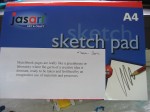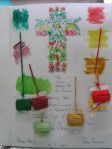Part Two: Project Four – In your sketchbook
Having just viewed Pat Hodson’s review of textile student Jackie Ward’s sketchbook http://news@oca-uk.com I will now have no excuses for not emulating her presentation for assessment.
The first obvious feature of her presentation is that it is all in a ‘fixed’ binder/notebook. Completing and controlling work in this form of sketchbook I find is @#$%^& difficult. Below my entry is all on loose sheets of A3 110gsm paper which can be either bound or held together with binder clips/rings for presentation to tutors and/or assessors.
The second obvious feature is that when presenting work that is not necessarily the ‘final’ work but a selection of work that can be something other than the work that was done last it may well have to be torn out of the middle of a ‘fixed’ sketchbook.



The first two images were chosen because of the contrasting light and dark shadings so that a comparison could be made between the various marks and colours. The image on the right was as a result of cutting three drawings into strips and interlacing them in a woven pattern. The result needs to be looked at from a distance in order to see the greater patterns and blocks of colour. Changing the scale of the image helps to clarify less meaningful marks and makes others more emphatic for further evolution.



A closeup and distant visual of an 8cm framed segment prior to enlargement and additional resolution. The outlines and squares are predominant and will need to be redrawn to show aspects other than geometrical shapes, depending of course on how the designer perceives an outcome of the chosen segment. The method used of weaving the slips of paper together gives structure and purpose to this exercise. Highlighting a small segment tends to isolate features that can be confusing when looking at the greater picture. Once again the colours black and white act as highlighters whereas the primary colours stand out just waiting to be composed further into designs which merge with a measure of staccato rhythm.


Showing a selection of the 8cm square chosen for enlargement and the base image from where other 8cm squares have been taken. The image on the left shows extreme markings of texture and undulating material. This was created with heat being applied to coloured plastic flower wrapping paper and then acrylic paint used on the surface.It has a raised surface/relief which adds another dimension to my work that has been mostly on a flat paper surface.



By using a double panel of mirrors at different angles various compositions are able to provide patterned pieces which lend themselves admirably to be developed in patchwork and quilting. The simple application of the mirrors becomes a valuable encouragement to working further with graph paper and/or computer aided designs ending up as either embroidery designs, hand stitched motifs or bed quilts to mention only a few options. Placing the mirrors at right angles or a variation of positions creates a sense of excitement in itself. I felt a great sense of achievement as I saw the possibilities especially in a wide choice of colours and painting sticks.




Cut and paste both on the computer and with scissors and paper are a meaningful way to create designs tantamount to deciding which ones lend themselves or are chosen to be stitched and/or sewn out. I am really chuffed about these exercises I think I am getting some where at last – well along the lines that I believe I should be developing designs. I am building up a great body of work at this stage with the exploration process being the main driver. I am not afraid to develop and use as many mediums as possible and as many new tools that I can lay my hands on. These images are only a selection of my current work with the purpose of showing how my work is evolving towards resolution and finished pieces.
Stumpage is a technical and commercial term for the value of a growing tree. Once the trunk is felled however death and decay set in and provide a feast of images which can be metamorphed into samples and experiments by textile and fibre artists.



Death and decay captured in water colour and black ink pen.



Mixed hand and machine sampling of textures and shapes on the face of the felled tree trunk. Strips of demin were woven into a piece of fabric and stitched on to hessian.



Trialling colour mixes and recipes for resolution of sampling.
Pattern forming so that the growth rings could be developed further into some form of wall hanging.







































You must be logged in to post a comment.